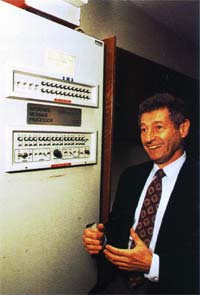A single person did not create the Internet that we know and use today. Below is a listing of several different people who've helped contribute and develop the Internet.

First network equipment:
August 29, 1969 the first network switch and the first piece of network equipment called "IMP", which is short for (Interface Message Processor) is sent to UCLA. On September 2, 1969 the first data moves from UCLA host to the switch. In the picture to the right, is a picture of Leonard Kleinrock next to the IMP.
The idea:
The initial idea is credited as being
Leonard Kleinrock's after he published his first paper entitled "Information Flow in Large Communication Nets" on May 31, 1961.
In 1962 J.C.R. Licklider becomes the first Director of IPTO and gave his vision of a galactic network. In addition to the ideas from Licklider and Kleinrock, Robert Taylor helped create the idea of the network, which later became ARPANET.
Initial creation:
The Internet as we know it today first started being developed in the late 1960's.
In the summer of 1968, the Network Working Group (NWG) held its first meeting chaired by Elmer Shapiro with the Stanford Research Institute (SRI) with attendees: Steve Carr, Steve Crocker, Jeff Rulifson, and Ron Stoughton. In the meeting the group discussed solving issues related to getting hosts to communicate with each other.
In December 1968,
Elmer Shapiro with SRI released a report "A Study of Computer Network
Design Parameters." Based on this work and earlier work done by Paul Baran, Thomas Marill and others; Lawrence Roberts and Barry Wessler helped to create the final version of the Interface Message Processor (IMP) specifications. Bolt Beranek and Newman, Inc. (BBN) was later awarded the contract to design and build the IMP sub network.
Introduction of the Internet to the general public:
UCLA puts out a press release introducing the public to the Internet on July 3, 1969.

First network equipment:
August 29, 1969 the first network switch and the first piece of network equipment called "IMP", which is short for (Interface Message Processor) is sent to UCLA. On September 2, 1969 the first data moves from UCLA host to the switch. In the picture to the right, is a picture of Leonard Kleinrock next to the IMP.
The first distributed message
and network crash
On Friday October 29, 1969
at 10:30 p.m., the first Internet message was sent from computer science Professor Leonard KleinRock's laboratory at UCLA, after the second piece of network equipment was installed at SLI. This connection not only enabled the first transmission to be made, but is also considered to be the first Internet backbone.
The first message to be distributed was "LO", which was an attempt at "LOGIN" by Charley S. Kline
to log into the SLI computer from UCLA. However, the message was unable
to be completed because the SLI system crashed. Shortly after the
crash, the issue was resolved and he was able to log into the computer.
E-mail is developed:
Ray Tomlinson introduces network e-mail in 1972. The first messaging system to send messages across a network to other users.
TCP is developed:
Vinton Cerf and Robert Kahn design TCP during 1973 and later publish it with the help of Yogen Dalal and Carl Sunshine in December of 1974 in RFC 675.
First commercial network:
A commercial version of ARPANET known as Telenet is introduced in 1974 and considered by many to be the first Internet Service Provider (ISP).
Ethernet is conceived:
Bob Metcalfe develops Ethernet idea in 1973.
TCP/IP is created:
In 1978 TCP splits into TCP/IP driven by Danny Cohen, David Reed, and John Shoch to support real-time traffic. This allows the creation of UDP. TCP/IP is later standardized into ARPANET in 1983 and is still the primary protocol used for the Internet.
DNS is introduced:
Paul Mockapetris and Jon Postel introduce DNS in 1984.
HTML:
In 1990
Tim Berners-Lee develops HTML, which made a huge contribution to how we navigate and view the Internet today.
WWW:
Tim Berners-Lee introduces WWW to the public on August 6, 1991.





No comments:
Post a Comment